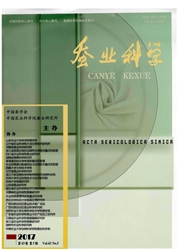

 中文摘要:
中文摘要:
采用PCR技术扩增6个地理种群桑天牛的线粒体细胞色素氧化酶Ⅰ(mt DNA COⅠ)基因序列,基于mt DNA COⅠ基因序列变异探讨不同地理分布桑天牛种群间的遗传距离、系统发育以及遗传分化程度。对6个地理种群的33个桑天牛样本的mt DNA COⅠ基因扩增产物的测序结果表明共有19个位点发生变异,占序列总长的4.0%,其中来自河南省济源的桑天牛有12个变异位点,来自浙江省的桑天牛有9个变异位点,来自河北省4个地区的桑天牛的变异位点较少;河北省的4个地理种群的遗传距离较小,在0.001 3-0.002 6之间,河北、河南、浙江种群间的遗传距离较大,其中河南种群与河北种群的遗传距离又远远大于浙江种群与河北种群的遗传距离,后2大地理种群分布区域的海拔更接近。利用MEGA4.1软件构建的NJ系统进化树显示,6个地理种群形成河北、河南和浙江3大地理分布格局;从遗传分化程度上来看,桑天牛种群的3大地理分布格局不存在共享的单元型,遗传分化系数(FST)在0.804 1-0.892 2范围内,遗传分化程度较高。综合分析认为,不同地理种群桑天牛存在分化的原因除地理分布外,更重要的是生态条件的差异。
 英文摘要:
英文摘要:
Mitochondrial cytochrome C oxidase Ⅰ( mt DNA COⅠ) gene sequences from six geographic populations of Apriona germari were amplified by PCR technology to analyze the genetic distance,molecular phylogeny and degree of genetic differentiation based on the sequence variation of mt DNA CO Ⅰ gene. Amplified product sequencing results of mt DNA COⅠ genes of 33 A. germari samples from 6 geographic populations showed that there were 19 mutated sites,accounting for 4. 0% of the total length of CO Ⅰ gene,among which 12 mutation sites were found in A. germari samples from Jiyuan of Henan Province and 9 mutation sites were found in those from Zhejiang Province. The A. germari samples from 4 districts of Hebei Province had less mutation sites. The 4 A. germari populations from Hebei Province had a closer genetic distance ranging from 0. 001 3 to 0. 002 6. The A. germari populations from Hebei,Henan and Zhejiang Provinces had a higher genetic distance. Among them,the genetic distance between A. germari populations from Henan and Hebei Province was much higher than that between A. germari populations from Zhejiang and Hebei Province,andthe latter had similar altitude of distributing regions. NJ phylogenetic tree constructed using MEGA4. 1 software showed that the 6 geographic populations of A. germari were divided into three geographical distribution patterns in Hebei,Henan and Zhejiang. In view of the degree of genetic differentiation,there were no haplotypes shared in the three geographical distribution patterns and theirgenetic differentiation coefficient( FST) ranged from 0. 804 1 to 0. 892 2,showing apparent genetic differentiation. Taken together,it is suggested that except geographical distribution,different ecological conditions are the more important reason that led to genetic differentiation of various geographic populations of A. germari.
 同期刊论文项目
同期刊论文项目
 同项目期刊论文
同项目期刊论文
 期刊信息
期刊信息
